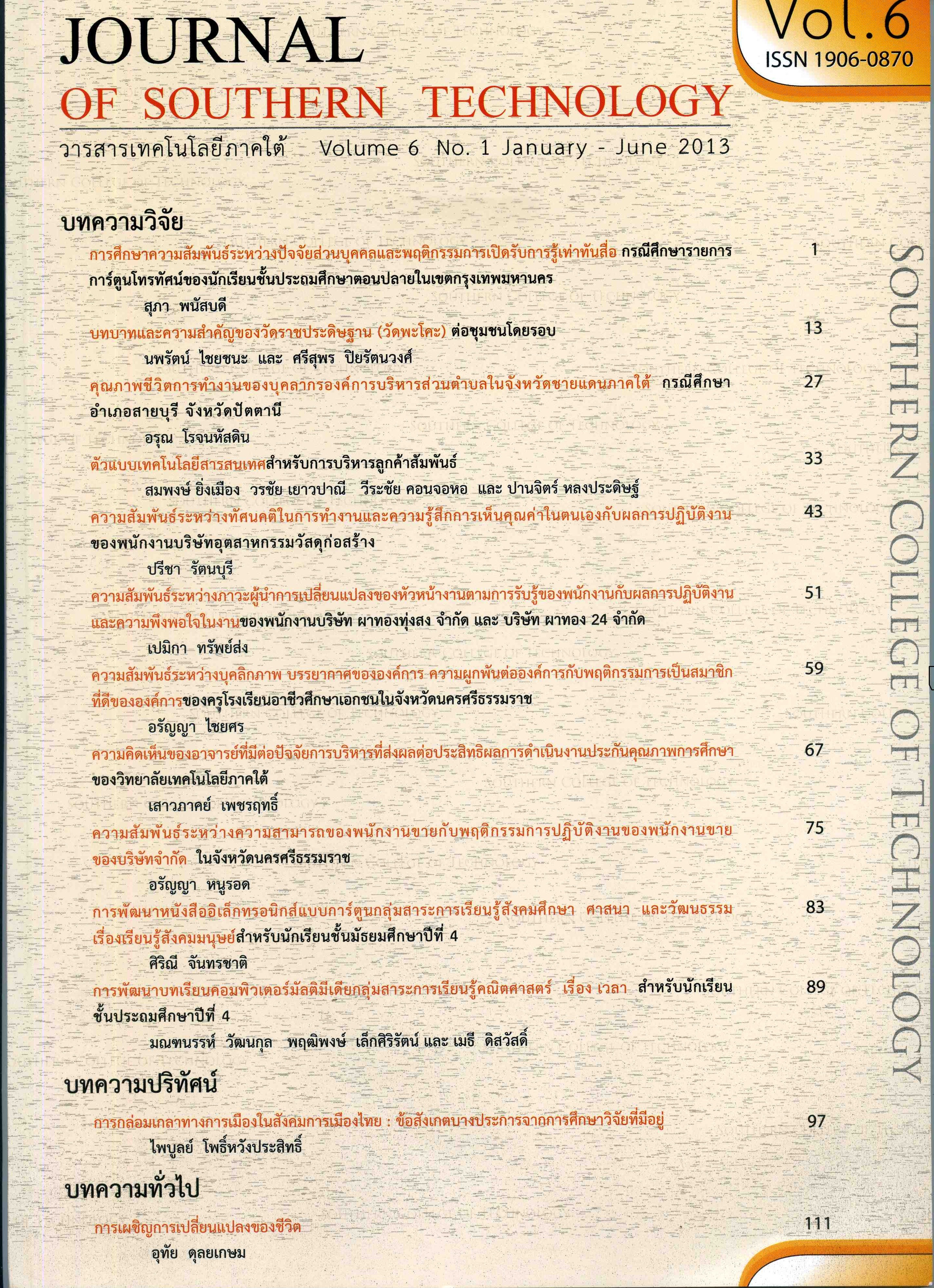The Development of Computer Multimedia Instruction on the Time Study in Mathematics Strand for Grade 4 Students
Main Article Content
Abstract
The objectives of this research were 1) to develop computer multimedia instruction on the time study in mathematics strand for grade 4 students to meet the 80/80 standard criteria, 2) to identify the efficiency index of the developed computer multimedia instruction, 3) to compare the academic achievement of the students who n taught with the computer multimedia instruction and those with the conventional lessons, and 4) to study the students’ satisfaction with the computer multimedia instruction. The sample for the study, drawn try using multi-stage sampling, consisted of 102 grade 4 students attending Anubansongkhla School during the second semester of the 2012 academic year. The instruments used in the study consisted of 1) the computer multimedia instruction on the time study in mathematics strand for grade 4 students, 2) a learning achievement test, 3) a questionnaire probing students’ satisfaction, 4) an evaluation form probing the efficiency of the computer multimedia instruction, and 5) learning plan for the topic of time. The data analysis used were percentage, arithmetic means, standard deviations and a T-test independent.
The findings of the study revealed that 1) the developed computer multimedia instruction achieved the efficiency of 83.92/81.00, 2) the developed computer multimedia instruction showed the efficiency index of 0.58, 3) the students who were taught with the computer multimedia instruction showing higher learning achievement than those taught with the conventional lessons at 0.05 level of statistical significant, and 4) the students show a ‘very high level of satisfaction with the developed computer multimedia instruction ( = 4.76, S.D. = 0.43)
Article Details
-
Authors must agree to the journal publication rules and allow the editors to edit the manuscripts for publication.
-
Author’s right belongs to the author but Journal of Southern Technology holds the right of first publication and thus allow readers to use the article for the purpose of education but not commercial.
References
กรมวิชาการ กระทรวงศึกษาธิการ. (2545). การพัฒนาและการใช้คอมพิวเตอร์เพื่อการเรียนการสอน : กรณีศึกษาโรงเรียน ประถมศึกษา. กรุงเทพฯ : โรงพิมพ์คุรุ สภา.
กรมวิชาการ กระทรวงศึกษาธิการ. (2544). ความรู้เกี่ยวกับสื่อมัลติมีเดียเพื่อการศึกษา. กรุงเทพฯ : ศูนย์พัฒนา หนังสือ.
จินตวีร์ คล้ายสังข์. (2554). หลักการออกแบบเว็บไซต์ทางการศึกษา : ทฤษฎีสู่การปฏิบัติ. กรุงเทพฯ : บริษัท สยามพริ้นท์ จำกัด.
ไชยยศ เรืองสุวรรณ์. (2546). เทคโนโลยีการศึกษา : ทฤษฎีการวิจัย. กรุงเทพฯ : โอเดียนสโตร์.
ทิศนา แขมมณี. (2545). ศาสตร์การสอน. กรุงเทพฯ : จุฬาลงกรณ์มหาวิทยาลัย.
ธาราวดี สมนาแซง. (2552). การพัฒนาบทเรียนคอมพิวเตอร์มัลติมีเดีย กลุ่มสาระการเรียนรู้คณิตศาสตร์ เรื่อง พื้นที่ผิวและ ปริมาตร สำหรับชั้นมัธยมศึกษาปีที่ 3. วิทยานิพนธ์ครุศาสตร์ (เทคโนโลยีและสื่อสารการศึกษา) สกลนคร, มหาวิทยาลัยราชภัฏสกลนคร.
บุปผชาติ ทัฬหิกรณ์. (2540). เครือข่ายใยแมงมุมโลกในโลกของการศึกษา. วารสารครู วิทยาศาสตร์,5(1), 18-23.
โรงเรียนอนุบาลสงขลา. (2553). รายงานสรุปผลสัมฤทธิ์ทางการเรียนปลายปี ปีการศึกษา 2551-2553 โรงเรียนอนุบาลสงขลา. สงขลา : โรงเรียนอนุบาลสงขลา.
วนิสา นิรมาณ. (2545). การพัฒนาบทเรียนคอมพิวเตอร์ช่วยสอนแบบมัลติมีเดียโดย วิธีการค้นพบเรื่อง ฟังก์ชั่นตรีโกณมิติ ชั้นมัธยมศึกษาปีที่ 4. วิทยานิพนธ์ ศิลปศาสตรมหาบัณฑิต, มหาวิทยาลัยศรีนครินทรวิโรฒ.
ศิริรัตน์ นิยมการ. (2550). การพัฒนาบทเรียนคอมพิวเตอร์มัลติมีเดีย เรื่องจำนวนและตัวเลข กลุ่มสาระการเรียนรู้คณิตศาสตร์ สำหรับนักเรียนระดับช่วงชั้นที่ 2. สารนิพนธ์การศึกษามหาบัณฑิต (เทคโนโลยีการศึกษา), มหาวิทยาลัยศรีนครินทรวิโรฒ.

